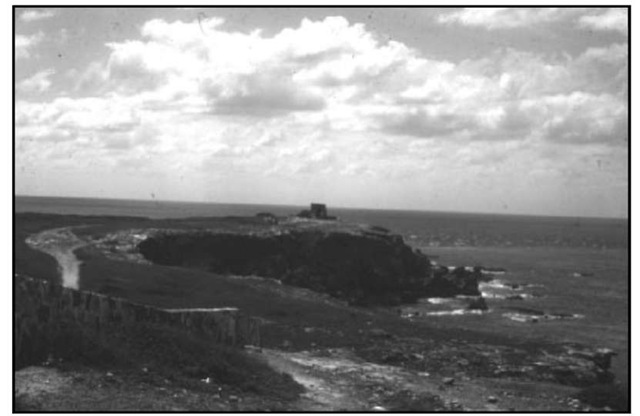Xelhua
The flood hero of the Aztecs’ creation legend, in which he sought refuge from the Deluge by climbing to the top of Tlaloc’s mountain. Tlaloc, together with Quetzalcoatl, was a version of Atlas, depicted in temple art as a bearded man supporting the four quarters of the sky as a cross on his shoulders. He was identified with a mountain, like Atlas, one of the Titans. Xelhua was also a giant who, just before the Great Flood, went with his followers to central Mexico, where they built the most massive structure in Mesoamerica.
Today, the Cholula pyramid is mostly overgrown and surmounted by a Catholic church which substituted an Aztec temple. It used to enshrine a meteorite fragment, a relic of the Deluge “which had fallen from heaven wrapped in a ball of flame.” Before the pyramid was completed, “fire fell upon it, causing the death of its builders and the abandonment of the work.” The original caption in Nahuatl, the Aztec language, to a native illustration of the Cholula temple read, “Nobles and lords, here you have your documents, the mirror of your past, the history of your ancestors, who, out of fear for a deluge, constructed this place of refuge or asylum for the possibility of the recurrence of such a calamity” (Nuttall, 269).
Cholula’s enshrined meteorite and related deluge tradition represent compelling evidence for an Atlantean catastrophe brought about by a celestial event.
The oldest date for the pyramid goes back to late pre-Classic times, no earlier than 400 b.c.; it was probably completed in its ultimate form around 200 a.d. These construction periods are many centuries after the 12th-century b.c. destruction of Atlantis, which the Cholula pyramid was intended to memorialize, thereby demonstrating how seminal the cataclysm continued to be regarded by subsequent generations of Mesoamericans. (See Asteroid Theory)
Xi Wang Mu
The Chinese goddess of compassion, also known as Kuan Yin, whose name and function as protectress of the Tree of Life from a sunken kingdom suggest Lemurian origins. She mythically represents an actual event—namely, the transference of Lemurian spirituality to China after the inundation of the Pacific realm.
Xicalancans
Described in the Cakchiquel Manuscript, a collection of ancient Mexican traditions collected for Spanish conquerors by Aztec chroniclers in the mid-16th century. The Xicalancans were said to be Mexico’s first civilized people, “forerunners of the races that followed; they came from the East in ships or barks” after the Third Sun. This was one of four epochs in Earth’s history defined by universal catastrophes. The Third Sun ended with the near-destruction of the world by “the fire from heaven.” Such an event places the arrival of the Xicalancans at sometime in the late third millennium b.c., when Atlanteans were fleeing the second series of their island’s major geological upheavals.
The Xicalancans were doubtless the same people archaeologists refer to as the “Olmecs,” who experienced a sudden increase in population about 1200 b.c., when Atlantis was finally destroyed. The progenitors of Mesoamerican civilization, the Olmec were believed to have developed their first ceremonial centers at La Venta, circa 1500 b.c., but further research by writer Zecharia Sitchin and others implies a more probable date around 3000 b.c.
Xmucane and Xpiyaoc
Cited in the Mayas’ great cosmological topic, the Popol Vuh, as the god and goddess who made the first animals and human beings. The beasts, however, grew into ferocious monsters, while men degenerated into mean, selfish perversions. Regretting their own creations, Xmucane annihilated the whole lot in a universal flood. In Plato’s account, the Atlanteans’ decadence similarly prompted their punishment.
Xochiquetzal
The Aztec mother of mankind after the Fourth Sun, or Age, when a former humanity was exterminated by the Great Flood. She was said to have been its only survivor, together with a mortal man, Coxcoxtic, with whom they repopulated the world. Their offspring were born without any capacity for speech, however, so Xochiquetzal called down the birds of the sky to lend their voices to her mute children. Her sons and daughters eventually grew up to wander all over the world, a myth that was used to explain the different languages of mankind.
Her sacred flower, the marigold, was a souvenir of the solar worship that mankind observed before the Deluge. In this, she suggests the antediluvian Golden Age mentioned by the Greek mythologist Hesiod. The Atlantean deification of the sun that Hesiod describes is the same veneration found in the Aztec myth of Xochiquetzal. Her name means “Feather Flower,” and she was believed to have preserved some pre-Flood dances, music, and crafts, so that they might be restored in Mesoamerican culture. If so, then some Aztec performing arts may have been handed down directly from their Atlantean forebears.

At the southern tip of Isla Mujeres, off the coast of Yucatan, stands a shrine to Ixchel, the Mayas’ flood heroine.
